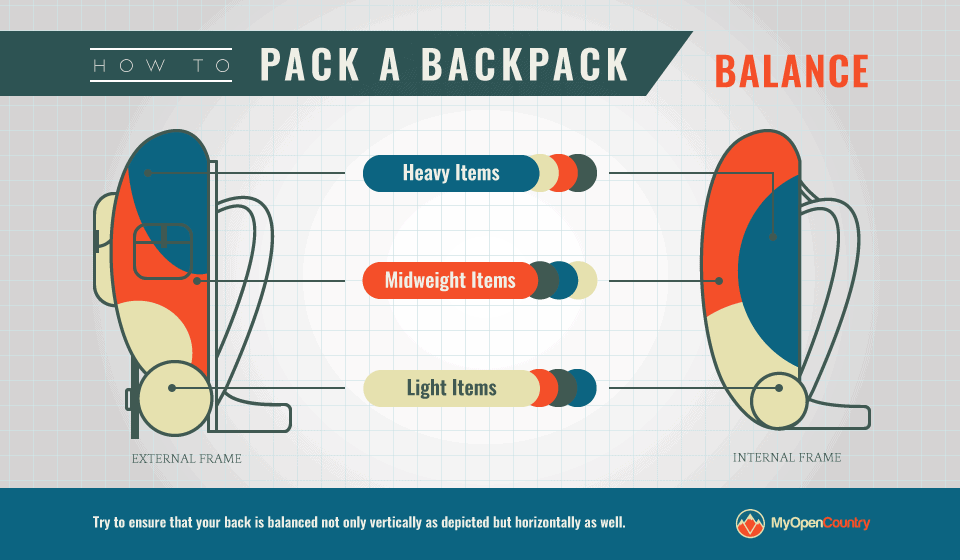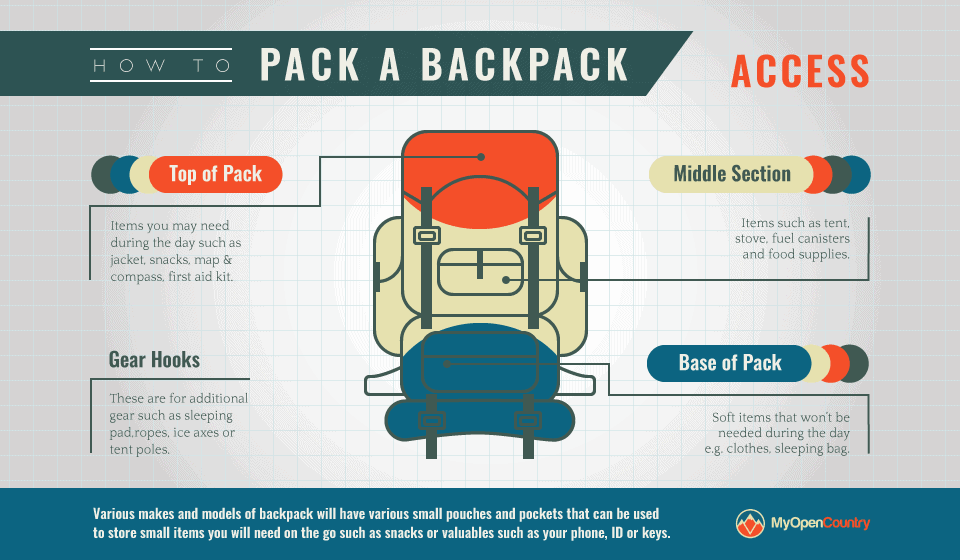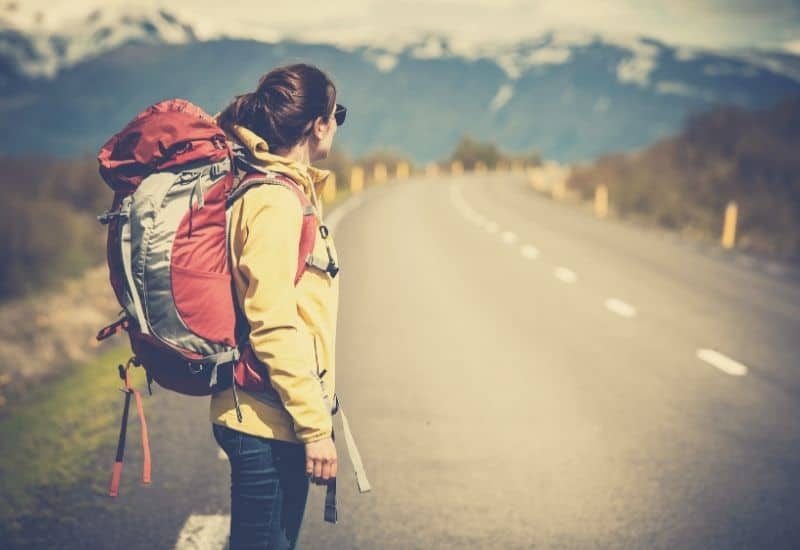There are many ways to skin a cat, or so the saying goes. There are as many ways you can pack a backpack, each one giving you a different spatial outcome when you finish.
Packing a bag well is an art form. That’s why it’s so necessary for campers, backpackers, or travelers of any sort to learn the best way to pack their gear. Without strategy and finesse, you have a mangled pile of clothes and gear, and you can’t fit everything you need inside.
Below, we will take a look at how to perform this art one step at a time.
Clothes Packing: Step-by-Step Instructions
Packing clothes in a backpack seems like it should be as easy as walking or riding a bike. We learned how to do it once, and now we have got the hang of it, we don’t have to learn anything else, right? Yet, there is much more to a good pack than meets the eye.
Start by assessing your clothes, learn the steps for folding each piece, and then develop a strategy.
#1 Lay Out All Your Clothing Items
Think about your trip. What are you going to be doing? Where are you going?
Will you need extra layers for chilly nights around camp?
What about a hat or thin long-sleeved shirt for sun protection?
In other words, make sure you have everything. You should balance preparedness with the need to reduce weight and increase space. Try packing light, but remember, having a couple more items than necessary is always better than a couple too few.
Once you see how much you really need, you can consider getting a compression dry bag to help it all fit. Be picky, though. Many times, while you’re packing, you find you can save space by getting rid of many things you don’t need.
#2 Fold Your Shirts
Shirts are a primary piece of clothing, and they are likely the piece that will need to get switched out the most, second only to undergarments. This includes clothing like T-shirts and long-sleeved shirts.
How to do the Army Roll Technique for Shirts
- Lay t-shirts or long sleeves on a flat surface.
- Take the bottom upward and over to create a 3″ cuff around the bottom.
- Move the left side of the shirt 1/3 of the way over, keeping the sleeve smooth and flat.
- Fold the left sleeve back over the folded 1/3 of the t-shirt.
- Fold the right side over the left crease bringing the right sleeve over itself.
- Tightly roll the shirt from the top of the shirt down over the cuff.
- Tuck the cuff inside out, tucking over the shirt.
#3 Fold Your Underwear
Underlayers, including socks, men’s and women’s underwear, and bras are all essential clothes no matter what kind of adventure calls you. You might think they are small, but it is precisely that characteristic that can make them deceiving.
Take your time with them, and you will be surprised how much space you can save.
How to Roll Pairs of Socks
Socks are best as balls, although the smaller the ball is, the better. Learn how to pack socks and tuck them neatly.
- Lay the socks flat on the table, one on top of the other.
- Roll them up from the bottom until you reach the top
- Hold the inside of the outermost sock.
- Pull the outside edge with your other hand while still gripping the inside to pull it around the sock ball.
- Tuck the other side in neatly
How to Fold Underwear
There are quite a few types of underwear for both men and women. Adapt these according to the type and amount of fabric on each pair.
Women
This method for rolling women’s underwear generally works best with bikini or similar styles of underwear. If you use boyshorts, you can even scroll down to the men’s boxer brief folding instructions.
- Lay underwear flat and with the front side up.
- Narrowly crimp the waistband of the underwear down three times towards the crotch.
- Flip the underwear over and fold each side of the waistband towards the center on top of each other.
- Roll the crotch up, so it lines up with the rest of the bundle.
- Inside the center of the bundle, there is a distinct pocket. Take this and flip it over the bundle inside out three times.
Men (Boxer Briefs)
- Flatten the underwear on a smooth surface.
- Fold the left leg over the middle and smooth it out.
- Tuck the right leg over the left side, so the edges form a straight line.
- Take the waistband halfway down and tuck the bottom half of the underwear into the waistband to make a tight bundle.
How to Fold a Sports Bra
Focus on folding a sports bra so that it is as thin of a rectangle as possible. This can be a challenge with the straps on a sports bra, but it’s worth it in the end.
- Lay it flat on the table with the back facing up.
- Fold the straps over so it forms a rectangle.
- Take the rectangle into thirds.
#4 Fold Your Pants
Pants are one of the bulkiest pieces of clothing in a backpack. However, there’s still room for improvement as regards space-saving when it’s time to get packing for your trip.
How to Fold Pants
- Lay the plants flat and smooth.
- Fold them in half so that the back side faces you.
- Crease the point of the crotch over the leg so the straight line of the leg seam.
- Fold the bottom of the pants in half to just below the belt loops.
- Take it in half again, bringing it up to the midpoint.
How to Fold Shorts
Folding shorts is a lot like folding pants, but without as much fabric to worry about. Fold the shorts in half along the seam line.
- Fold the bottom of the pants to the edge of the waistband.
- From the right side to the center and take the left side over the middle.
#5 Fold Your Mid Layers and Shell Layers
Layers like jackets and sweaters are the bulkiest pieces of clothing to take on any trip. However, packing enough of these layers also helps protect you from inclement weather or frosty nights. Pack them well, and you will hardly notice they are there anyway!
- Zip the jacket up if applicable.
- Lay it out flat with the arms spread out and hood to the side without creasing.
- Fold the sweater’s right side to the left to form a straight crease from the hood’s edge to the sweater’s bottom edge.
- Fold the sweater’s arm back and right, crease it at the edge and fold the bottom third back to the left.
- Fold it from the left over to the center. Take the arm to the edge and back over to the left and right again.
- Spread the hood out and bring it down.
- The sweater should look like a rectangle. Fold the rectangle down from the top into thirds.
#6 How to Pack Clothes in a Hiking Backpack Strategically
As we mentioned at the beginning of the article, it might seem silly to go into packing your bag with a strategy. It’s not like we are planning a war. Except, in a way, we are waging war for the extra space in our pack. A stellar packing strategy goes a long way towards winning that particular war.

Effective load distribution helps balance your bag so that you don’t feel like tipping more to the right than the left when you put it on, or vice-versa. Evenly distributing all of that weight also does wonders for aching muscles, allowing all of your body to do equal amounts of the work.
Packing a backpack well also helps make the load more comfortable since no part of the bag should feel like it is poking into you, making you feel top-heavy or putting pressure on a back or shoulder muscle. The heavier your load, the more applicable this is.
The Strategy
Start packing in a backpack the clothes that won’t be needed until you reach camp, i.e. your pajamas or long underwear. Put those at the bottom of the back with items like sleeping bags, camp shoes, or your tent.

Before putting any pairs of shoes inside, stuff them with clothes to use up the negative space inside. Socks fit particularly well.
Next up are all of the heavyweight camping items. Things like your camp stove and cookware should go in the middle. This will make them accessible if you decide to cook up dinner before setting up camp and also situates them closer to your waist. This helps to keep your center of gravity closer to the ground and improves balance.
Put all of the clothing and gear you need access to quickly at the top of the pack. These could include a mid-layer jacket, rain gear, or your on-the-go food stash.
Pack any small essentials into your accessory pockets. These are things you might want urgently or need to access frequently. A map, compass, bug spray, water bottle, headlamp, ID, cash, car keys, sunscreen, and rain cover all fall into this category.
Oversized items that don’t fit well in your pack can conveniently go outside of it on your tool loops and lash-on points. These include:
- Tent
- Trekking poles
- Ice ax
- Crampons
- Climbing rope
- Sleeping pad
If you have followed all of the folding, rolling, and packing steps for your clothes and are still short on space, you can create more by using stuff sacks or compression dry bags to compress your clothing even more. A dry bag goes, of course, also brings the added benefit of keeping your items dry in bad weather.
End it all by tightening up the compression straps on your pack. Doing so stops the gear shifting and consolidates the entire load.
How to Pack Clothes in a Backpack…
We hope that you enjoyed our article on learning how to pack clothes in a backpack. When you have all your duds and gear laid in front of you, squeezing them into your backpack can seem like an unmanageable task. However, by following the above tips, and with a little practice, we know you will become a bag-packing master in no time at all.
If you learned something new from this article or have any comments or questions about how to pack a backpack, let us know in the comment section below!

